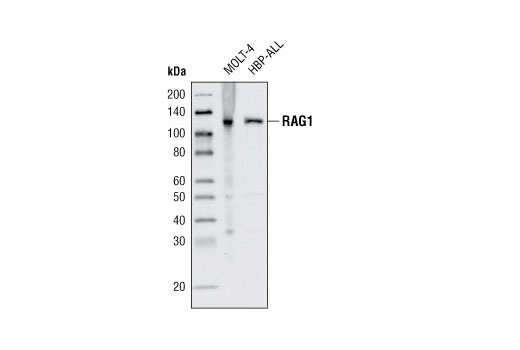WB, IP
H
Endogenous
119
Rabbit IgG
#P15918
5896
Product Information
Product Usage Information
| Application | Dilution |
|---|---|
| Western Blotting | 1:1000 |
| Immunoprecipitation | 1:50 |
Storage
Specificity / Sensitivity
Species Reactivity:
Human
Source / Purification
Monoclonal antibody is produced by immunizing animals with recombinant human RAG1 protein.
Background
The sequences encoding antigen receptors are split into multiple germline segments which are then combined by a process called V(D)J recombination during immune cells development. A variable (V) segment is combined with a joining (J) segment, and in some cases a D (Diversity) segment, to create the antigen-binding portion of the receptor. The recombined V(D)J segment is then spliced into exons that encode the constant region to produce mature mRNA (1,2). This essential process required for the development of functional immune T and B cells creates a vast diversity in these receptors (3,4). Initiation of this process follows binding of RAG1 (recombination activating gene 1) and RAG2 to the conserved recombination signal sequences (RSS) and the introduction of a double-strand break between the RSS and the coding sequence (5,6). RAG1 and RAG2 genes are located immediately adjacent to each other in the genome and lack introns in their coding regions in many species. RAG1 and RAG2 are coexpressed only in the B and T cell lineages and both are required for cleavage activity (7). RAG1 and RAG2 can also function as transposases, contributing to chromosomal translocations and lymphoid malignancy (8,9). Mutations in the RAG genes are associated with a spectrum of combined immune deficiencies in humans (10,11).
- Schatz, D.G. (2004) Semin Immunol 16, 245-56.
- Gellert, M. (2002) Annu Rev Biochem 71, 101-32.
- Alt, F.W. et al. (1992) Ann N Y Acad Sci 651, 277-94.
- Sadofsky, M.J. (2001) Nucleic Acids Res 29, 1399-409.
- Swanson, P.C. (2004) Immunol Rev 200, 90-114.
- Swanson, P.C. et al. (2009) Adv Exp Med Biol 650, 1-15.
- Fugmann, S.D. et al. (2000) Annu Rev Immunol 18, 495-527.
- Hiom, K. et al. (1998) Cell 94, 463-70.
- Agrawal, A. et al. (1998) Nature 394, 744-51.
- Villa, A. et al. (1999) J Clin Immunol 19, 87-97.
- Corneo, B. et al. (2000) J Biol Chem 275, 12672-5.
Species Reactivity
Species reactivity is determined by testing in at least one approved application (e.g., western blot).
Western Blot Buffer
IMPORTANT: For western blots, incubate membrane with diluted primary antibody in 5% w/v BSA, 1X TBS, 0.1% Tween® 20 at 4°C with gentle shaking, overnight.
Applications Key
WB: Western Blotting IP: Immunoprecipitation
Cross-Reactivity Key
H: human M: mouse R: rat Hm: hamster Mk: monkey Vir: virus Mi: mink C: chicken Dm: D. melanogaster X: Xenopus Z: zebrafish B: bovine Dg: dog Pg: pig Sc: S. cerevisiae Ce: C. elegans Hr: horse GP: Guinea Pig Rab: rabbit All: all species expected
Trademarks and Patents
Limited Uses
Except as otherwise expressly agreed in a writing signed by a legally authorized representative of CST, the following terms apply to Products provided by CST, its affiliates or its distributors. Any Customer's terms and conditions that are in addition to, or different from, those contained herein, unless separately accepted in writing by a legally authorized representative of CST, are rejected and are of no force or effect.
Products are labeled with For Research Use Only or a similar labeling statement and have not been approved, cleared, or licensed by the FDA or other regulatory foreign or domestic entity, for any purpose. Customer shall not use any Product for any diagnostic or therapeutic purpose, or otherwise in any manner that conflicts with its labeling statement. Products sold or licensed by CST are provided for Customer as the end-user and solely for research and development uses. Any use of Product for diagnostic, prophylactic or therapeutic purposes, or any purchase of Product for resale (alone or as a component) or other commercial purpose, requires a separate license from CST. Customer shall (a) not sell, license, loan, donate or otherwise transfer or make available any Product to any third party, whether alone or in combination with other materials, or use the Products to manufacture any commercial products, (b) not copy, modify, reverse engineer, decompile, disassemble or otherwise attempt to discover the underlying structure or technology of the Products, or use the Products for the purpose of developing any products or services that would compete with CST products or services, (c) not alter or remove from the Products any trademarks, trade names, logos, patent or copyright notices or markings, (d) use the Products solely in accordance with CST Product Terms of Sale and any applicable documentation, and (e) comply with any license, terms of service or similar agreement with respect to any third party products or services used by Customer in connection with the Products.

